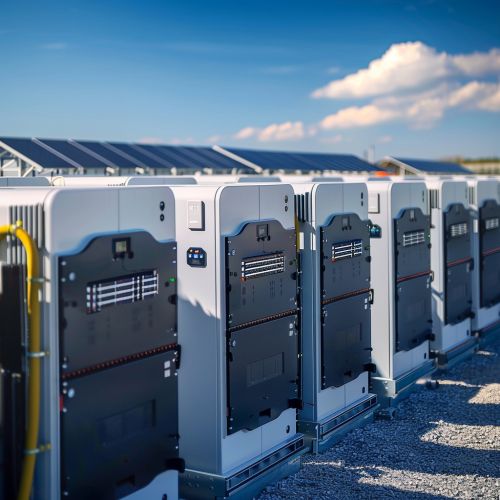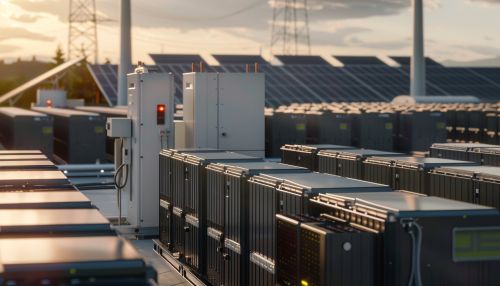Battery Storage
Introduction
Battery storage, also known as battery energy storage systems (BESS), refers to the technology that allows for the storage of electrical energy in batteries for later use. This technology is critical in modern energy systems, especially with the increasing integration of renewable energy sources like solar and wind power, which are intermittent by nature. Battery storage systems help balance supply and demand, enhance grid stability, and provide backup power during outages.
Types of Battery Storage
Battery storage systems can be categorized based on the type of battery used. The most common types include:
Lithium-Ion Batteries
Lithium-ion batteries are the most widely used type of battery storage due to their high energy density, long cycle life, and relatively low self-discharge rate. They are commonly used in portable electronics, electric vehicles, and grid storage applications. The chemistry of lithium-ion batteries involves the movement of lithium ions between the anode and cathode during charging and discharging cycles.
Lead-Acid Batteries
Lead-acid batteries are one of the oldest types of rechargeable batteries. They are known for their reliability and low cost. However, they have a lower energy density and shorter cycle life compared to lithium-ion batteries. Lead-acid batteries are often used in uninterruptible power supplies (UPS) and backup power systems.
Flow Batteries
Flow batteries store energy in liquid electrolytes contained in external tanks. The energy capacity of flow batteries can be easily scaled by increasing the size of the tanks. They are suitable for large-scale energy storage applications, such as grid storage, due to their long cycle life and ability to provide a steady output over extended periods.
Nickel-Cadmium Batteries
Nickel-cadmium (NiCd) batteries are known for their robustness and ability to perform well in extreme temperatures. However, they suffer from the "memory effect," where the battery's capacity decreases if it is not fully discharged before recharging. NiCd batteries are used in aviation, portable tools, and emergency lighting.
Sodium-Sulfur Batteries
Sodium-sulfur (NaS) batteries operate at high temperatures and offer high energy density and efficiency. They are primarily used in large-scale grid storage applications. The technology involves a molten sodium anode and a sulfur cathode separated by a solid electrolyte.
Applications of Battery Storage
Battery storage systems have a wide range of applications across various sectors:
Grid Stabilization
Battery storage systems play a crucial role in stabilizing the electrical grid by providing frequency regulation, voltage support, and load balancing. They can quickly respond to fluctuations in supply and demand, ensuring a stable and reliable power supply.
Renewable Energy Integration
The integration of renewable energy sources, such as solar and wind, into the grid presents challenges due to their intermittent nature. Battery storage systems can store excess energy generated during periods of high production and release it during periods of low production, thereby smoothing out the variability and enhancing the reliability of renewable energy.
Backup Power
Battery storage systems provide backup power during outages, ensuring continuity of operations for critical infrastructure, such as hospitals, data centers, and communication networks. They can also be used in residential settings to provide backup power during grid failures.
Electric Vehicles
Battery storage is a key component of electric vehicles (EVs), providing the energy needed for propulsion. Advances in battery technology have led to increased driving ranges and reduced charging times for EVs, making them a viable alternative to internal combustion engine vehicles.
Off-Grid Power Systems
In remote or off-grid locations, battery storage systems are used in conjunction with renewable energy sources to provide a reliable and sustainable power supply. These systems can reduce dependence on diesel generators and lower operating costs.


Technical Considerations
The design and implementation of battery storage systems involve several technical considerations:
Energy Density
Energy density refers to the amount of energy stored in a given volume or mass of the battery. Higher energy density allows for more compact and lightweight battery storage systems, which is particularly important for applications like electric vehicles and portable electronics.
Cycle Life
Cycle life is the number of charge and discharge cycles a battery can undergo before its capacity degrades significantly. A longer cycle life translates to a longer-lasting battery, reducing the need for frequent replacements and lowering the overall cost of ownership.
Efficiency
The efficiency of a battery storage system is determined by the ratio of the energy output to the energy input. Higher efficiency means less energy is lost during the charging and discharging processes, making the system more cost-effective and environmentally friendly.
Safety
Safety is a critical consideration in battery storage systems, as batteries can pose risks such as thermal runaway, fire, and explosion. Proper design, manufacturing, and management practices are essential to ensure the safe operation of battery storage systems.
Cost
The cost of battery storage systems includes the initial capital cost, operating and maintenance costs, and the cost of replacement over the system's lifetime. Advances in battery technology and economies of scale are driving down costs, making battery storage more accessible and economically viable.
Future Trends
The future of battery storage is shaped by ongoing research and development aimed at improving performance, reducing costs, and expanding applications:
Solid-State Batteries
Solid-state batteries use a solid electrolyte instead of a liquid one, offering higher energy density, improved safety, and longer cycle life. They are considered a promising technology for next-generation battery storage systems.
Second-Life Batteries
Second-life batteries are repurposed batteries from electric vehicles that still have significant capacity remaining. These batteries can be used in less demanding applications, such as stationary energy storage, extending their useful life and reducing waste.
Advanced Materials
Research into advanced materials, such as silicon anodes, lithium-sulfur, and lithium-air chemistries, aims to enhance the performance and reduce the cost of battery storage systems. These materials have the potential to significantly increase energy density and cycle life.
Grid-Scale Storage
The deployment of grid-scale battery storage systems is expected to grow, driven by the need for grid stability, renewable energy integration, and decarbonization. Large-scale projects, such as Tesla's Hornsdale Power Reserve in Australia, demonstrate the potential of battery storage to support the grid.
See Also
- Renewable Energy
- Electric Vehicles
- Grid Stability
- Energy Density
- Cycle Life
- Solid-State Batteries
- Second-Life Batteries
